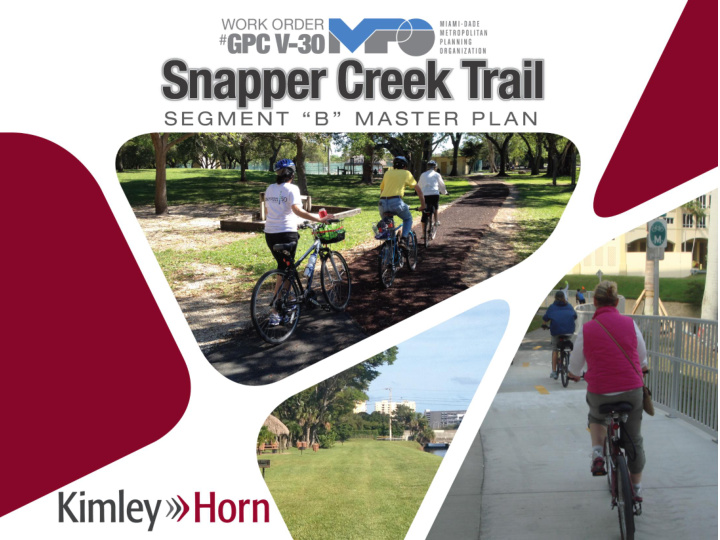



Tonight’s Program 2
Workshop Objectives Learn about the draft proposed short-term and long-term alignments Voice potential concerns and provide input Help shape future plans for the Snapper Creek Trail Segment B corridor 3
Snapper Creek Trail Segment “B” Aerial Map 4
Snapper Creek Trail Segment “A” Completed master plan to the north and west of the current study area 5
County Greenway Network 506 miles of greenways, trails and bike lanes proposed 34 trails planned Snapper Creek Trail, Segment B 6
Over 100 miles of bicycle/pedestrian facilities have been built to date…
… including many canal trails 8
Connections to existing corridors and destinations 9
10
Study Objectives Improve facilities for bicycling and walking Provide effective alternatives to short auto travel Promote healthier lifestyles Improve safety 11
Corridor Constraints Crossing Palmetto Expressway Canal sections where the right-of-way is narrow Canal sections where the right-of-way has been consumed Access control at street crossings Mid-block arterial roadway crossings SW 87 th Avenue / Snapper Creek Canal (C-2) intersection SW 72 nd Avenue / Snapper Creek Canal (C-2) intersection SW 67 th Avenue / Snapper Creek Canal (C-2) intersection 12
Community Information Workshop Held on April 27, 2016 at South Miami City Hall Attracted 29 workshop attendees Open house format and a formal presentation was given to provide the public with a project overview and context 13
Community Information Workshop 14
Community Information Workshop Public feedback included both positive support messages and concerns from residents adjacent to the canal Need to consider short trips/connections within the study area as well as regional mobility Residents along the canals raised concerns Garbage/Waste Noise Security Privacy Cost Safety Property Value of Depreciation Narrow Right-of-Way 15
Recommendations 16
Short-Term Alignment 17
Mid-Term Connector Opportunity/Alignment 18
Long-Term Alignment 19
Insets 20
Insets 21
Insets 22
Insets 23
Insets 24
Insets 25
Insets 26
Insets 27
Infrastructure Needs Shared-Use Path Shared use paths are non-motorized transportation trails that are typically used by bicyclists and pedestrians. Shared use paths may vary from a wide sidewalk in the street’s right -of- way to a paved trail separate from the roadway such as a canal or park. Neighborhood Greenways Enhanced shared streets that will improve connectivity to residential areas. It incorporate a variety of elements including bicycle shared lane markings (sharrows), traffic calming, and bike route and wayfinding signage to provide a comfortable and low-stress environment that encourages the use of non- motorized modes of transportation. 28
Shared-Use Path 29
Neighborhood Greenway 30
Other Important Features Rectangular Rapid Flashing Beacon (RRFB) Allows non-motorized traffic an opportunity for a safer mid-block crossing. Consists of a high emphasis crosswalk with two flashing, rectangular shaped beacons that light up to alert motorists when someone is using the crosswalk. 31
Other Important Features Canoe/Kayak Launch At Dante Fascell Park/south end of SW 58 th Avenue neighborhood greenway Connects to the County’s blueway network. 32
Demonstration Project Shared use path along the canal between Dadeland North Metrorail Station and SW 67 th Avenue/Ludlam Road Provide a shared-use path along the north bank of the Snapper Creek (C-2) Canal from U.S. 1/S Dixie Highway to SW 67 th Avenue. Provide a trail connection to connect to SW 85 th Street while still restricting motor vehicle traffic. Install RRFBs across SW 67 th Avenue at the trail crossing. Install zig-zag pavement markings on SW 67 th Avenue as advanced warning of the trail crossing. 33
Demonstration Project 34
Demonstration Project 35
Thank You! for listening to tonight’s workshop presentation 36
Recommend
More recommend